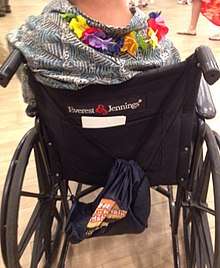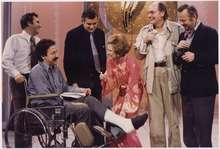Everest and Jennings
Everest & Jennings was a manufacturer of mobility and adaptive equipment. Everest & Jennings was the first company to mass-produce wheelchairs.

Origins
Herbert A. Everest and Harry C. Jennings Sr. were friends, and both were engineers. Herbert Everest was also physically disabled after surviving a mining accident in 1918. Everest complained to Jennings about the bulk of chairs available in the early 1930s, and in 1933, the pair designed and built a lightweight, collapsible model in Jennings' garage.[1] The design was patented in October 1937.[2]
The pair soon went into business to manufacture their improved design. In the 1940s, they supplied disabled veterans of World War II through government contracts that established the company as a recognized name in rehabilitation equipment.[3][4][5]
The Everest family sold its interest in the company in 1943,[6] but Gerald Jennings, son of Harry Sr., was chief executive from 1952 until he retired in 1985.[7][8]
Success and legal troubles

By the early 1970s, Everest & Jennings International was "the world's largest supplier of wheelchairs."[9] But this status brought increased scrutiny.[10] In 1977, the United States Justice Department formally accused Everest & Jennings of practices that violated antitrust laws. The resulting settlement required Everest & Jennings to make annual compliance reports to the Justice Department; the settlement was called "little more than a slap on the wrist" by consumer advocate Ralph Nader.[11] Nader was also involved with protests about the quality, safety, and price of Everest & Jennings chairs, by a disability rights group.[12] A class action suit was brought by equipment dealers, but dismissed in court in 1984.[13]
Everest & Jennings recorded sales of $145 million in 1980, and profits near $8 million.[14] In the 1980s they launched "Avenues," an adaptive clothing line for wheelchair users.[15] Changes within the company and in the business landscape during the 1980s left Everest & Jennings struggling at decade's end.[16]
Later developments
In 1992, facing financial difficulties from lost market share,[17] Everest & Jennings moved from Camarillo, California to St. Louis, Missouri.[18] In 1993, the company acquired Medical Composite Technology, a carbon fiber technology company.[19]
In 1996, still struggling with debt and falling sales, Everest & Jennings announced the sale of the company to Graham-Field Health Products.[20] Graham-Field soon closed the Everett & Jennings plant in Earth City, Missouri.[21] Graham-Field continues to market wheelchairs under the Everest & Jennings name.[22]
Notable customers
Among the prominent early users of Everest & Jennings wheelchairs were Franklin Delano Roosevelt, Sergeant Alvin C. York and Winston Churchill.[23] Ed Roberts and other members of the Rolling Quads used Everest & Jennings power chairs.[24] Author Joni Eareckson Tada once wrote, "If they ever made a statue of me, I would want my 300-pound Everest & Jennings power chair front and center."[25] Actor Christopher Reeve's first wheelchair after becoming quadriplegic in 1995 was made by Everest & Jennings.[26]
References
- N. R. Kleinfield, "Wheelchair Manufacturer Target of Complaints" The Index-Journal (April 22, 1981): 12. via Newspapers.com

- Raymond V. Smith and John H. Leslie Jr. Rehabilitation Engineering (CRC Press 1990): 195-196. ISBN 9780849369513
- Richard I. Bourgeois-Doyle, George J. Klein: The Great Inventor (NRC Research Press 2004): 166-168. ISBN 9780660193229
- Geoffrey Reaume, Lyndhurst: Canada's First Rehabilitation Centre for People with Spinal Cord Injuries, 1945-1998 (McGill-Queens Press 2007): 49. ISBN 9780773576476
- M. Tremblay, "Going Back to Civvy Street: A Historical Account of the Impact of the Everest and Jennings Wheelchair for Canadian World War II Veterans with Spinal Cord Injury" Disability & Society 11(1996): 149-170.
- Everest Jennings Inc. vs. E. J. Manufacturing Co. United States Court of Appeals, Ninth Circuit.·263 F.2d 254 (9th Cir. 1959).
- "Gerald M. Jennings, Wheelchair Maker" New York Times (November 8, 1989).
- "Gerald Jennings; Ran Wheelchair Firm" Los Angeles Times (November 8, 1989).
- "Obituaries: Harry C. Jennings Jr." Manhattan Mercury (July 13, 1976): 2. via Newspapers.com

- Jack Anderson and Les Whitten, "Yes, Virginia, There is a Justice Department" Daily Standard (December 26, 1977): 2. via Newspapers.com

- "Wheelchair Manufacturer Deal Blasted by Nader" The Pantagraph (May 29, 1978): 5. via Newspapers.com

- "Wheelchair Builders Rip Off the Disabled, Nader Group Says" The Independent Record (December 24, 1976): 15. via Newspapers.com

- "Wheelchair Maker Claim" Santa Cruz Sentinel (March 22, 1984): 20. via Newspapers.com

- N. R. Kleinfield, "Wheelchair Manufacturer Target of Complaints" The Index-Journal (April 22, 1981): 12. via Newspapers.com

- "'Avenues' Fashion Models are on Wheels, not Heels" Santa Cruz Sentinel (September 6, 1989): 38. via Newspapers.com

- James F. Peltz, "Wheelchair Maker Tries to Regain Profits" Los Angeles Times (April 3, 1990).
- Joseph P. Shapiro, No Pity: People with Disabilities Forging a New Civil Rights Movement (Crown/Archetype 2011): 214-218. ISBN 9780307798329
- Larry Speer, "Wheelchair Company to Lay Off 450: Camarillo" Los Angeles Times (February 29, 1992).
- Guy Lasnier, "Bike Company Aims for Comeback" Santa Cruz Sentinel (May 22, 1994): 21. via Newspapers.com

- Lee Conrad, "Everest & Jennings CEO Getting $660,000 from Stock" St. Louis Business Journal (June 23, 1996).
- "Court Okays Everest & Jennings Plant Shutdown" St. Louis Business Journal (June 27, 2000).
- David J. Morrow, "Vehicles for Market Share; Wheelchair Makers are Trying to Expand their Turf" New York Times (January 21, 1998).
- James Bates, "Wheelchair Maker Looking For a Way Back to the Top" Los Angeles Times (March 3, 1987).
- Ben Mattlin, Miracle Boy Grows Up: How the Disability Rights Revolution Saved My Sanity (Skylight Publishing 2012): 36. ISBN 9781616087319
- Joni Eareckson Tada and Steve Jensen, Barrier-Free Friendships: Bridging the Distance Between You and Friends with Disabilities (Zondervan Press 1997): 124. ISBN 9780310210078
- Rebecca Grilliot, "Remembering a Superhero" HomeCare Magazine 27(11)(November 2004): 82.